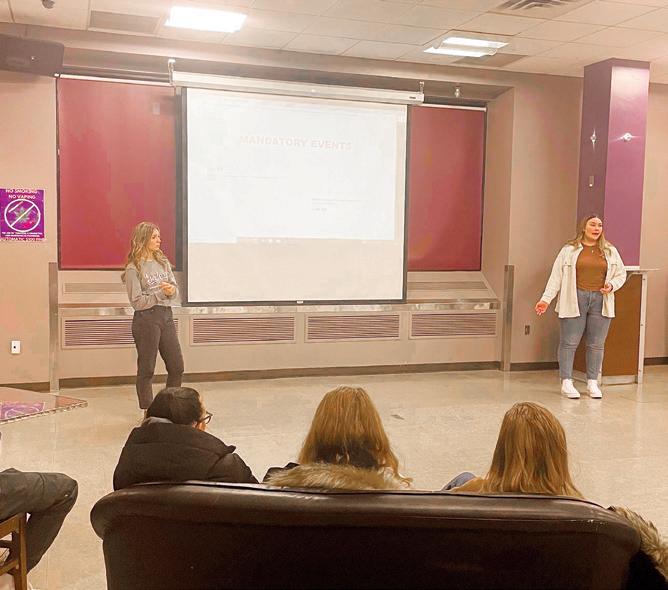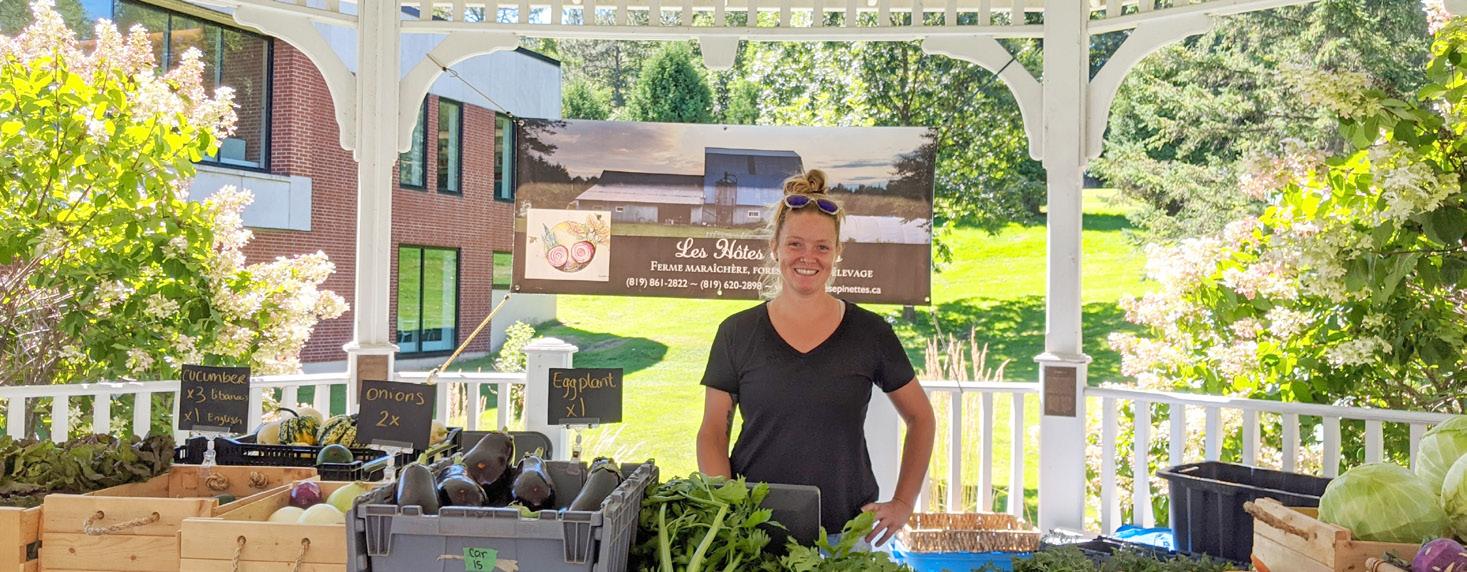






Dr. Shoshannah Bryn Jones Square organized a live poetry event on Dec. 16, 2022. This event featured live music, paintings, and poetry, and lasted a little over three hours with many guest speakers. The event was catered by Sodexo and offered free wine and food for whoever was interested.
Naaz Sidhu, a student at Kwantlen Polytechnic University in Surrey, B.C., performed at multiple points during the event as a guest speaker. She flew in from British Columbia to perform some of her very powerful spoken word poetry. Sidhu touched largely on her experience as a woman of color and immigrant in Canada.
Alex Bergeron, a musician in the band, Year of Glad, performed a piece that seeks to create ambient soundscapes, focusing on a technical and precise style. Alex Bergeron described Year of Glad as a band that entices the listener to become enraptured in the many layers of complexity that was found in their music.
Eric Manolson’s piano playing accompanied a few videos about his research in battling Alzheimer’s through music. His inspiring videos revealed his lifelong dedication to music as a means of healing. Manolson accompanied Markayza Mitchell’s performance of Nina Simone’s “Feeling Good”. Eric’s performance ended with an original protest song that blended musical
elements from Bobby McGuire and Bob Dylan into a new and distinct piece.
Following Manolson, the show became an open mic venue for poetry. There were many moving and powerful performances that followed. Literature students seized this venue as an opportunity to showcase the best of their writing. After the early performances, the crowd was electric and grew in fervor with each unique and highly stylistic performance from the students.
At the end of the event, conversation did not stop. Most performers mingled and exchanged information. The sentiment surrounding this event was clear; it was a complete success and demanded an encore. Many professors who had attended spoke about the need for these sorts of events and congratulated Dr. Square for organizing such a successful event.
With about a month having passed since the event, it is clear that excitement around the evening has not faded and there is interest to run another poetry night during the winter semester of 2023.

Extra Day – previously known as Club Day – took place on the first day of classes, Jan. 11 from 1:00-3:30 p.m. in the Gait. The event has changed its name from “Club Day” due to the inclusion of groups such as the Indigenous Cultural Alliance (@ bu_ica_), the Jewish Student Association (@bishopsjsa), the Caribbean African Students Association (@ubishopscasa), the Sexual Culture Committee (@ busexualculturecommittee), and Muslim Student Association (@msabishops) on Instagram – which are not under the “club” designation. Clubs, groups, teams, and associations arrived 15 minutes early to set up their assigned stations, which were positioned to form an open circle in the Gait.
SRC Extra Day runs at the beginning of each semester as a semi-connected event with Orientation Week, though all are welcome and encouraged to attend. This academic year, both events were
run midday on the first day of classes –potentially inconvenient for some students, but receiving still an impressive turn out. Each table presented their own display: a trifold board, a flag, a poster, a sign-up sheet, or in particularly fun cases, candy. The American Sign Language (ASL) Club (@buaslclub) and Bishop’s University Pride Alliance (BUPA - @bupridealliance) handed out candy and pride flags respectively and were met with enthusiastic attention. It was a chance to be creative, meet new people, and promote your group.
Some departments also have societies which attend SRC Extra Day. The Sports Studies Society (@bu_sposo), Science Society (@busciencesociety), English Literature Society (@englit_ubishops), and the Astronomy, Mathematics & Physics Society (@buamps) were some of the societies in attendance this semester. For those wanting to meet more students with similar academic pursuits, these groups are a fantastic way to get connected.
Outside the Gait in the SUB, Bishop’s
International set up a table during the first few days of the new term for incoming international students to learn about the campus and how to navigate it.
For people who were not able to join SRC Extra Day, the SRC Extra Instagram page (@ busrc.extra) has a full list of all the clubs, groups, societies, and associations currently active this year. It is also a good platform to follow for notifications on campus extracurriculars, from Eco-Week events to new club announcements to occasional department wine and cheese notices. With events starting up again this semester, now is a great time to find people with similar interests or backgrounds and make new friends!
Much of Quebec missed out on the typical white Christmas this year as mild temperatures and rain made for a warm winter break. Winter sports and activities have had a late start, and travellers have been stranded by the unseasonable storms.
The local ski season started off weeks later than it typically does, with ski hills relying heavily on manufactured snow. Several local mountains have not yet fully opened and few people are turning up on the slopes. Mont Sutton, which lost power for multiple days in late December, has yet to open several chairlifts and trails. Bromont has opened just over half of the hill. Few cross-country ski routes have opened. While American tourists have been filling up the resorts, people across Canada have been noting unusual winter weather.
For much of late December and early January, Montreal’s high was above 0 degrees, where typically the city would be averaging at -4 in other years. The average low was only -1 degrees Celsius, as opposed to the
typical -14. While weather this mild is rare for Montreal, it has grown increasingly more commonplace in the last 20 years. These weather patterns in December and January have only occurred five times since 1875; however, three of these occurrences have taken place since 2007. In December of 2007, the city hit a record high of 12 degrees.
In Sherbrooke, the weather patterns are similar, with an average of -1 degrees in the last two weeks. Nearly every ice-skating rink remains unopened, and those that are open have less than ideal conditions, having melted and refrozen several times over.
The unseasonably warm weather serves as a grim reminder of the effects that climate change will have on Eastern Canada. Québec’s per capita greenhouse gas emissions are some of the highest in the world, with poor plans from the provincial government to address and lower the production of emissions. Southern Ontario and
Quebec are expected to warm almost twice as quickly as much of the rest of the world, and Northern Quebec is expected to warm three times as quickly. Future winters in Quebec are predicted to be approximately 5 degrees warmer than previous winters. This will likely lead to increased frequency of flash floods in the region, which the current infrastructure is poorly prepared for.
Winter is on its way, with temperatures expected to dip to seasonal averages in the coming weeks. Freezing rain is forecasted to hit the city, and the Eastern Townships can expect a wet winter. However, in future winters, Quebec can expect to experience the consequences of climate change more severely.
Ever thought about working for Bishop’s after graduation?
Have you enjoyed your experience at Bishop’s? Do you want to bring that experience to others? Are you looking for some awesome post-grad work experience?
If yes, this job could be for you!Here is what to expect / what we do:
Briefly, the Recruitment and Retention Office is responsible for recruiting new Gaiters to Bishop’s. Our

Recruitment Officers represent the university throughout Canada, and across the world, both virtually and in person. When not visiting schools or taking part in fairs, our staff is performing all the important administrative tasks involved with the position.
For more information and to learn how to apply, follow the link below!
If interested, please send your CV and Cover Letter to careers@ubishops.ca by January 29th, 2023 at 4 pm.
Housing options in Lennoxville are plentiful, but the benefits of each can easily be lost in the rush to get a lease. Off-campus, students can choose from a variety of apartments, houses, and studios — often signing leases as early as October of the year prior to moving in. The large variations in pricing and duration of lease are typically the main issues that students face when finding a place to stay. On campus, however, options are more limited. Students can choose between apartment style dorms, a single room, or a shared room, depending on their priorities.
At Bishop’s, the only apartment-style residence is Paterson Hall, located on the back of the campus, behind Dewies. Each apartment contains four bedrooms, two bathrooms, and a communal kitchen and living room area. Paterson Hall is primarily inhabited by upper year students, who live with friends or are randomly assigned roommates. Paterson students, who have access to kitchens, are
the only students in residence who are not obligated to pay for a meal plan through Dewies. Living in Paterson gives students more room and more independence than other dormitories, but costs more than other rooms, and requires students to live with roommates.
Single rooms in the bog-style residence halls are the most popular rooms among firstyear students. A bog is a single room that shares a bathroom with one neighbour. The building is a typical residence in other respects, such as a communal kitchen, common rooms, and laundry facilities. Munster, Abbott, and Kuehner Halls, as well as the new residence, are all bog-style, giving students some independence while still providing them an easier social life through their bog mates and frequent RA-hosted events. Students who want to meet more people on campus, who want to be on the meal plan, and who want more modernized dormitories will benefit from bog-style living. However, bog-style residences are more expensive than traditional-
style residences, and, in addition to rent, students are also required to pay for the meal plan, making this residence style unaffordable for many students.
Students looking for a more economical option will benefit from the rooms offered in the traditional-style residence of Mackinnon. Mackinnon is the most affordable residence offered at Bishop’s, with shared bathrooms and rooms that have not been recently renovated, but available in singles or with a roommate. Instead of the double beds and larger rooms available in bog-style residences, traditional residences offer twin beds and small rooms. The variations in price are not great enough to account for the difference in quality between traditionalstyle and bog- and apartment-style residences.
Students applying for on-campus housing for the first time would benefit most from bogstyle residences than traditional residences, since traditional rooms are poorer quality for price. Upperyear students who want to stay on
Theabsence of a poetry club is a huge missed opportunity for students at Bishop’s. After the Empathy, Social Justice, and the Arts event took place on Dec. 16, it was clear that there is no shortage of poetry on campus. The event, a poetry reading night featuring poet Naaz and hosted by Dr. Shoshannah Bryn Jones Square, was extremely popular and begged the question: Why is there no poetry club if there is this much interest?
This would be an invaluable club to form as it could serve as an intersection for much of the creative writing done at Bishop’s. The club could meet biweekly and focus on the sharing of ideas and themes among different forms of poetry. Similarly, with the existing solid foundation of writers, this club could be an access point for new writers to get feedback and assistance.
The nature of the club has many advantages since professors from the English department could serve as guest speakers. Students within the club would become more acquainted with the English literature professors, and students outside the department would still be able to receive high quality feedback on their literary forays.
A poetry club serves as a venue to sharpen creative writing skills, something that classes often do not sharpen, instead assigning argumentative essays. Similarly,
for many English students, classes that cover literature offer few opportunities to apply the knowledge gained in the classroom. A poetry club would offer students a forum to creatively engage with the material they have encountered in the classroom.

Students who minor in literature have even fewer opportunities to engage in writing, since they have a stricter set of classes to attend that are focused largely on contextualizing English as a discipline (although the English department also offers minors in English, film and media studies, and communications). For example, in most 100-level English classes, teachers will use poems and short stories to provide context for different periods of literature.
Unfortunately, these classes rarely have the time to offer an opportunity for students to write poetry of their own because of the scope of the class. A club would encourage students to apply this knowledge while working with peers who are similarly interested in improving their writing skills.
campus typically apply to Paterson, though many who want to remain in dorm-style residence live in Abbott Hall. Students should try to avoid traditional style in favour of the more attractive residences on campus.
Asa second-year literature honors student, my experience has reflected that course codes are vague indicators that often do not accurately reflect course content. Generally, higher level course codes correlate with more precise content, implying that it requires prerequisite knowledge. For example, ENG112 covers a vast scope of history from 600 CE to 1600 CE, covering the English language as it transitions from old to middle to modern English. ENG310 focuses on Old English as a language, concentrating on a smaller window of time with a greater depth.
This idea translates well for these two courses, but this format breaks down when considering classes that are not historical or when considering the difficulty of readings and evaluations. There is no obvious precursor to classes that analyze individual literary genres or creative writing. The nebulous nature of these classes makes it difficult to gauge how many readings are appropriate to cover the content. I have had 300-level courses that used three books or fewer, while some of my 200-level classes required up to six books. While the number of books seems to be trivial, the quantity of readings often translates to workload. Heavier readings take more effort than classes with fewer readings.
Beyond the quantity of readings, course evaluations are also

not standardized. While most 100-level classes do not ask more than 1500 words for a final assignment, 200- and 300-level classes vary heavily in word count and difficulty. Personally, I have had 200-level classes with final essays that range from 1800 words to 3500 words. Ironically, none of my 300-level classes have been the most difficult or demanding during their semesters.
students tend to flock to professors they find more agreeable because the course code is largely irrelevant. This removes the focus on the material since literature students often find themselves enrolling with the same professor regardless of the course content, because they know they are comfortable with the teacher’s style of instruction.
Standardizing the number of books and essay length would dispel the common discrepancies found in the difficulty of English classes. Personally, I would be more likely to choose classes in certain domains that I otherwise avoid if I knew I could expect a similar workload in every course. The way that the English department currently operates leads to students gravitating towards particular fields due to the professor rather than the content.

I do not take the course code into consideration anymore when looking at English classes. The workload and difficulty is largely dependent on the professor and how well I can understand the material. A problem arises when describing classes to other students. Within the literature department,
Following the new year, the start of the semester, and the return of students to campus there is an event held by the BU SRC known as Survive the Gait. Survive the Gait offers students the chance to receive fully paid tuition for the semester (at the Québec rate), which encourages students to participate in a series of challenges in an intense, yet friendly competition. Having an inclusive competition among peers allows people to play competitively while also bonding and making friends.
The process is much like the play style of the hit TV show Survivor, making for a large and memorable experience in the small setting of the Gait. Survive the Gait employs many features that are common in high production value game shows, which contrasts the small town nature of Bishop’s event. This makes it unique
and entertaining especially when making notice of the compact setting yet large stakes of play. Holding challenges within the isolated play area of the Gait poses its limitations, and students who choose to attend the Gait from Jan. 21-28 will have an opportunity to see what unique challenges await participants.
Events like Survive the Gait held by the SRC are what attract students to become even further included in Bishop’s community, once seeing the carefully planned events the school has to offer. A benefit of increasing the number of on-campus activities similar to Survive the Gait and making them available for students is that students can safely get out of their comfort zone and fully experience Bishop’s as it is meant to be.
In a conversation concerning campus events, the group came to an agreement that having more events throughout the year may also result in higher student approval rates and also satisfaction scores. Also, there has
been an increasing level of involvement from students since the end of COVID-19 restrictions, inviting such events. These events will make for a lively and inclusive student-driven campus that would only build Bishop’s
reputation
.
Both
Gaiter squads had early returns to practice in the midst of the holiday season. The women arrived on Dec. 27 to begin preparing for their 2023 RSEQ and national championship push, heading into the semester with an undefeated 6-0 league record and a second overall national ranking.
The men arrived back on the same day but instead in Montreal, for two matches at L’Université du Québec à Montréal. They are set to play Lakehead University on Dec. 28, and the University of Calgary on Dec. 29. The Gaiters started off the Olga Hrycak Classic with a statement win, taking down Lakehead in a fast-paced game in which Bishop’s won by a score of 96-91. Through aggressive play and continuous intention to push the ball in transition, they were able to beat the #9 U Sports nationally ranked team at their own game. Tiernan McDougall led the way with a breakout performance, contributing a game-high of 25 points, doing so efficiently, in just 23 minutes of playing time. McDougall’s prowess was coupled with another strong performance from Rowan Halpenny, who provided pace and rim pressure, supplying the squad with 24 points, 7 rebounds, and 3 assists. Also notable was Charles-André Robert who had 15 points and 9 rebounds.
The following day, the team matched up against the Calgary Dinos, a consistent contender in the Canada West, who were set to be a physical challenge for the Gaiters. The team found themselves in an early deficit, but were able to head into the second half with an even score of 36-36. It remained a close match throughout the last two quarters but the men ultimately succumbed to strong execution down the stretch by the Dinos, falling to a final score of 70-63 for Calgary. Étienne Gagnon had a career-high of 30 points and 9 rebounds, shooting 1323 from the field. Ambs Mathé also contributed with 9
points and 6 rebounds.
The women had a productive winter camp, getting into the gym twice a day, incorporating consistent athletic development training with film sessions and technical meetings in preparation for a critical second semester for the team and the program. With five senior players, a 3-time First Team All-Canadian, Amaiquen Siciliano, two more All-Stars, Jael Kabunda and Victoria Gauna, as well as the reigning RSEQ defensive player of the year, Jennifer Louis, the women are in an incredible position to make a serious run in the second half of the season. They are poised to be serious contenders on the provincial and national stage.
On Jan. 6, the team traveled to Québec City to face off against the Laval Rouge et Or who they had previously beat earlier in the season by a margin of 9 points. This time, they were set to start without integral player Victoria Gauna due to an injury. She has been averaging 16.5 points and 7.2 rebounds thus far this season. Also out was Sandra Mbekou, who has been a consistent role player for the team.
In a neck and neck, back and forth game, it all came down to a final shot for the Gaiters with only a few seconds left on the clock. A strong defensive possession by Laval and a miscommunication by Bishop’s would lead to Laval being able to close out the game and take down the Gaiters by only 1 point. The Gaiters were led by Amaiquen Siciliano with 20 points, a double-double from Jael Kabunda with 17 points and 11 rebounds, and Katerina Stoupas who flirted with a double-double, pouring in 9 points and 13 boards. Associate Head Coach Rod Gilpin commented that: “our biggest concerns are getting our transition defense sorted out, and rebounding at both ends.” The team looks to take care of both and return to the hardwood strong and in full force after the bye week.
The men subsequently followed at 8 p.m. The
Gaiters came out strong, leading the game by a score of 19-12 after the first period. The Rouge et Or responded accordingly, closing the lead and maintaining a close match for the rest of the way.
Despite Bishop’s grabbing 25 offensive rebounds, crucial mistakes in the clutch minutes from the Gaiters, including untimely fouls and turnovers, would result in the team failing to maintain the lead and fall to the opposing team by 3 points. Étienne Gagnon, the fourth highest rebounder in the country, proved again his dominance on the glass, obtaining 19 in the game alongside 19 points. Rowan Halpenny also went to work again with 19 points and 7 rebounds.
The team now sits at a record of 2-5 and is focused on continually developing the detail-oriented aspects of their systems that have proved to be critically important and defining so far in the 2022-23 season.
Next up, the Gaiters will play Concordia University in a back-to-back series starting in Montreal on Thursday, Jan. 19. Their first home game of 2023 is Saturday, Jan. 21 in Mitchell Gym. The women’s game will start at 6 p.m. and the men will follow at 8 p.m.
The Bishop’s University Competitive Dance Team has started off the new year by launching its annual 50/50 fundraising event on January 6. With just $10 you stand the chance to win one of two $500 cash prizes!
The dancers are raising funds for the Be U competition in Mississauga, ON, where they will be representing Bishop’s University in March. The dancers have been preparing for this competition since October of 2022. They are in the studio every Sunday (all day) and every Monday night. They compete in multiple dance styles including jazz, contemporary, hiphop, and ballet. Yet, the competition stage is not the only place where you can find these talented dancers. The hiphop team supports a number of hockey and basketball games during quarters and halftimes, so expect to see some of these dancers performing this season!
You can support the dance team by participating in a simple draw. Contact any member of the competitive dance team, choose how many squares you would like to purchase and pick your lucky number(s). It is that easy! The winners are selected at random with the help of a random name generator, so everyone has an equal chance to win. Of course, the more tickets you buy, the higher the probability of winning. However, you do not need to buy many tickets to win. The winner from the last 50/50 fundraiser only purchased a single ticket and won the $500 cash prize!
Here are a few thoughts by the dancers regarding the upcoming competition:

I’m really excited about bonding with the team and spending time getting to know each other better in a high stress environment.
- Makayla FosterComing from a small island, I never had the opportunity to attend a dance competition and it’s crazy that we’ll be competing in a few months. I never thought I’d actually take part in one.
- Lisa van der Spaan
 Kitzan - Sports Editor
Kitzan - Sports Editor
In their first game of the second semester the Gaiters women’s hockey team came up short against the University of Montréal Carabins, posting a 6-2 loss on the road. This brings the team’s record to a very respectable 8-3-3 to begin their sophomore campaign as a member of U-Sports.
The two goals in the loss were recorded by Neleh Vigneau Sargeant and Justine Turcotte, with both of them also registering an assist and their linemate, Maude Pépin assisting on both of the team’s goals. Unfortunately, the Gaiters ran into a red hot player on the other end of the ice with the Carabins Audrey-Anne Veillette recording four goals in the game. The Gaiters turned away 24 of 30 shots while the University of Montréal let in
two goals on 22 shots in the hard-fought battle.
The Carabins have seemingly had the Gaiters’ number to start the year, with the Carabins taking all three of their contests with Bishop’s to date, with an overtime and one-goal win earlier in the year. In what should be some exciting hockey, the two teams will face each other two more times this year, giving Bishop’s the chance to rewrite the script and finish off strong in the five-game season series.
In other team news, captain Marie-Camille Théorêt was named to the World University Games to represent Canada on an international level in December. With 11 points through 14 games coming from the blue line as well as regularly recording top minutes for the Gaiters, it is no wonder she was selected
to play for team Canada. The tournament was held in Lake Placid beginning Jan. 11, with a game against Slovakia. With her selection, Théorêt becomes the first Gaiter to represent team Canada at an international tournament in women’s hockey. This is an honorable achievement and we wish her the best of luck in the tournament.
With eleven regular season games remaining, you can guarantee that the team will be looking to continue their strong beginning to the season. Eight of those games will be held at home at the Jane & Eric Molson arena. The Gaiters will be taking on the University of Ottawa Gee-Gees on the road Jan. 13, followed up by their next home game Jan. 15 at 3:30 p.m. against the Carleton Ravens.
in 2006, the Bishop’s University Ski Club, also known as BU Snow, is a popular club at Bishop’s known for bringing awareness to fun University-community gatherings, great ski pass deals for numerous ski hills, and hosting as well as creating fun events for the ski community year round.

Selected through an application process, the ski club has seven members of the executive board who are all responsible for working closely with the SRC to make the annual rail jam at Winterfest a reality, but that is not all they do. The executives are also responsible for making new merchandise items like the BU Snow sweaters and stickers, maintaining tight relationships with ski hill staff and event coordinators, and thinking of fun new events as well as bringing those ideas to fruition. The club even offers ski and snowboard wax and sharpenings for $15 behind the scenes for the Bishop’s ski community with a speedy turnaround time.
During their weekly meetings, the executives go over the previous minutes from the past meeting, the progress of planning events that were previously discussed, and the current standing of the treasury. Once completed, they then bring up new topics and goals to discuss such as exclusive merchandise for Winter-
fest, what the process of making new events will look like, how information about events will be effectively communicated to the Bishop’s community and what external companies or groups may be needed to make the event a success. Once they have defined what they need to do and the best way to do it, the executive members divide up the roles among themselves so it is easier to achieve their goals in a shorter period of time. Most projects require many hours of research and collaboration with other brands, companies, and groups.
Currently the ski club is working hard planning for the upcoming gear swap on Jan. 21 from 12-4 p.m. at the Optimist Park skatepark. They are also making sure that the 2023 Winterfest is going to be a time to remember, with some creative new Winterfest-inspired exclusive merchandise and an amazing rail jam filled with great times and fun memories. Keep an eye out for news and updates about upcoming events on their Instagram and their Facebook group chat @bu_snow.
party.
The United States midterm election of November 2022 created an unstable landscape for the American government. The Republicans, who, according to polls and historical trends, were set to take overwhelming control of the legislative body, failed to win a majority in the Senate and only garnered a slim majority in the House. This dismal performance, coupled with previous divisions stemming from party infighting, has left political analysts unsure of the effectiveness of this House majority.
This was compounded by a new development concerning the election of a new Speaker, which must take place before the legislative session. The U.S. Constitution created the office of Speaker of the House, but there are no legal or constitutional rules encompassing the election or the powers of the speaker. The standard practice is for a candidate, traditionally party leaders, to be suggested by both the minority and majority parties, with representatives voting on the one they believe would be most capable of fulfilling the duties of speaker. These duties are undefined but usually include procedural duties such as maintaining order and announcing bills as well as sometimes leading the policy agenda of the House. Because of the importance of these duties, the majority, especially in recent years, will almost certainly elect a member of their own
The current divisions in the Republican party, and the slim majority, made this election particularly troubled. Kevin McCarthy, a Republican from California and previous House minority leader, is the one who achieved victory. This, however, was a hard-fought victory, requiring 15 consecutive voting rounds, the most since the American Civil War. The stalemate caused Donald Trump to voice support for McCarthy, against the wishes of his supporters in the House who would have preferred Trump to be speaker (Trump is not currently serving in any political position, but the Constitution does not explicitly require the Speaker to be a member of Congress). In order to win the support of this rightwing faction, McCarthy conceded many articles on the rules package, a document formalizing the procedural rules of the House, which is usually the first vote held by the members of the House. The rules package was voted on separately, with McCarthy’s changes, and narrowly passed.

Even on the 15th vote, McCarthy only won because some members of the House abstained from voting, lowering the threshold. The modifications made to the rules package significantly weakened McCarthy’s position by allowing any representative to call for a vote removing him as Speaker. Other concessions included giving more seats on the House Rules Committee to far-right representatives, capping spending, and
removing metal detectors around the House floor, according to USA Today. The support of Donald Trump was particularly relevant since the holdouts were the so-called “freedom caucus”. Mirroring the Democrats’ “progressive” caucus, this Republican caucus is a subgroup that pushes right-wing ideology and rhetoric. With well-known members such as Matt Gaetz and Marjorie Taylor Green, they have amassed considerable popular support from much of the Republican electorate. They continue to peddle the idea that the 2020 election was stolen from Donald Trump and subscribe to many other ideologies divergent from the mainstream, particularly their distrust of vaccines and disagreement with LGBTQ2S+ rights.
While the current division of the House, Senate, and Executive Branch almost ensures the American legislative process will grind to a halt, this instability in the House will also weaken its ability to pass budgets and likely nullifies any remaining chance of passing productive legislation. This situation also foretells a future where the Republican party becomes splintered between its traditionally conservative establishment and its more radical new members.
While this may seem like a foreign, distant issue, the repercussions of this instability will likely be felt within Canada. The U.S. Congress is constitutionally responsible for trade and the United States accounts for 65 per cent of all Canadian imports. Most impor-
TheSRC’s Winter O-Week, the smaller sister of its fall component, began on Sunday, Jan. 8, and concluded on Thursday, Jan. 12. Of the 400 new students, roughly half were entering a graduate program. Another half of the incoming undergraduates were exchange students, according to SRC Director of Events, Hannah MacQueen. Because of that, O-Week had to be planned not just for a smaller group of students (as it is designed mainly for undergrads) but be adaptable to the size of the crowd. There was uncertainty about how many transfer or exchange students would be able to arrive that week. Unlike Fall O-Week, there were no judges. Instead, O-Week participants split into just two teams, and participation hovered between 15-50 people per event.
The Opening Ceremony was held at the Gait on Sunday night. While it did not draw as large of a crowd as other events, students such as Ayla Vandenhende, from Belgium, pointed to the ceremony as one of the highlights of their week – as a space to be among and meet others in the same boat. Morgan Bain, from Ottawa, also said the Opening Ceremonies were a favourite. It helped us “get into the
spirit of things,” she said, echoing MacQueen’s comment on how O-Week brings people feeling anxious or homesick together. The SRC distributed O-Week packs at the ceremonies, had the participants sign up for teams and led team bonding games. MacQueen mentioned that part of the presentation included a Land Acknowledgement and explanation of the Acknowledgements’ purpose and significance. Many students were coming from abroad, she said, and even those who were Canadian may not be familiar with why Land Acknowledgments are conducted.
Monday’s Dewies team breakfast served to inform off-campus students this was a dining hall open to them as well. Later that day, students bused to the Carrefour de l’Estrie mall and ventured to the Combat d’Archers Sherbrooke for a high-energy archery-styled dodgeball game.
Tuesday’s two mandatory events, the academic tours and Bystander Training, brought a higher number of attendees, at least 40, according to MacQueen. Adam Ahlstrano Christensen, an exchange student from Denmark, said that he enjoyed BU International’s information session at Centennial Theatre. “It was just so wholesome,”

he commented, being able to hear from different students and learn about the resources offered. Vandenhende, too, spoke of O-Week being particularly supportive to transfer students settling in. One thing Christensen wished had been added to the information session was more perspective on Canadian academic culture and academic expectations at Bishop’s – navigating the “norms” of the classrooms. He expressed that the academic tours were useful, saying that those who had not joined “missed out”, since he still had a bit of trouble finding his classroom that morning. That night’s pizza and trivia at the Gait proved to be the most popular event in attendance, according to MacQueen, and several students stayed for the open bar afterward.
Wednesday’s SRC Extra Day at the Gait saw a bustling room of new and seasoned Gaiters making their way through a circle of club booths. Temitope, a graduate student from Nigeria entering the computer science program, signed up with the Caribbean and African Students Association and explained that she had just arrived at Bishop’s that day – the BUSRC Club Fair was her first O-Week event. “Everyone here is so nice and friendly,” she said, speaking of people’s willingness to help
tantly for this community, the Eastern Townships is a region which acts as the gateway for much of the trade between the two countries. Furthermore, trade does not only account for goods. International students and researchers are also regulated through trade deals. In the worst-case scenario, a Speaker who fails to unite the House or is consistently pushed towards the right could lead to a weaker academic integration between the two countries.
answer her questions. Later that afternoon, a group of participants went sledding on the golf course. Mentioning how she went sledding that day too, MacQueen noted that because of the smaller number of students, “I could interact with them much more than I could have in the fall.” O-Week wound down on Thursday with a garage sale open to all, held by the Sustainable Development Office and Buildings & Grounds, and finally, the Closing Ceremonies bringing the festivities full circle back to the Gait.

From
Feb. 6 to 10, Bishop’s annual Eco-Week will return with many exciting surprises! Eco-Week is a week to appreciate and raise awareness of environmental threats and sustainable development, whether on campus or globally. There are a number of current issues that need to be tackled. This includes food security, natural hazard pattern fluctuations, land degradation, pollution and sea level rise, all of which are tied to climate change, which is becoming a more prominent threat in the world today.
Last year, Eco-Week was marked by the virtual launch of the Sustainable Development Plan, which holds many objectives such as reducing waste, becoming carbon neutral by 2030, improving sustainable performance through projects and awareness, increasing food security, supporting social and cultural inclusion, and increasing academic programs and research related to sustainable development on campus. Last year’s EcoWeek also featured a mini market which was quite a success and will happen again this year.
For this year, we are aiming to increase participation and attendance from the Bishop’s community so that students can understand the importance of having an eco-friendly campus and be influenced to start their own sustainable initiative. As such, the Environmental Club, in collaboration with the SRC and the Sustainable Development Office, is organizing a week full of activities
and events on campus to welcome all community members. Other student unions such as BUnited and BU Outdoors will also hold events and activities within the environmental theme. While the planning of the events has not been finalized, a tentative schedule will feature the following events.
On Monday, we will kick off the week with a forum in the SUB to explain what Eco-Week is about, along with promoting ecological resources. Throughout the day, there will be an indoor mini market and thrift store in the SUB where students can sell or buy clothes and other goods, and free coffee will be provided by the Fair Trade Committee. The leftover clothes will be donated to a thrift store in Sherbrooke. Many clubs and student associations will have booths in order to promote their groups and advertise more green lifestyles. This event will involve the Environmental Club, Sustainable Agriculture and Food Systems Club, BU Outdoors, Indigenous Cultural Alliance, Model United Nations, Sustainable Development Action Group, and the SRC.
On Tuesday, the day will start with a Bring Your Own Mug opportunity in the Quad where coffee will be served, and this will be continued every morning for the rest of the week. Later on, there will be an art workshop as well as a trivia night in the Gait. On Wednesday, all students are welcome to attend the eco-tour in order to visit places on campus with sustainable initiatives as well as the beautiful natural landscapes nearby. The day will end with an insightful presentation by Dr. Matthew
Peros, the co-chair of the Department of Environment, Agriculture, and Geography. On Thursday, BU Outdoors will host a hike, but this event is still to be confirmed. Friday will be International Winter Bike Day, which will be celebrated with a bike ride in collaboration with Vélo Québec. Finally, there will be a greenhouse tour in the Johnson building and a movie night to end the week.
It is important to keep in mind that the dates for these events are prone to change. If you are interested in keeping up and attending these events, be sure to follow the Environmental

The success of the CSA basket program during the fall semester caused the Bishop’s Sustainable Development Office to seek out a provider for a winter CSA basket. They settled on Le potager d’Émylou, a family farm that provides CSA to over 200 families and has worked with Bishop’s in the past. The student subscription began on Nov. 23 and ends April 19, and includes a small vegetable basket every two weeks, at a fee of $20 per basket.
CSA, or Community Supported Agriculture, is a common source of revenue for smaller farms. Customers pay in advance to receive produce regularly for a set number of weeks, and accept whichever vegetables are in season. Generally, CSA programs run during the typical farm season, from May to October, but many farms have begun to offer winter CSAs in order to meet the demand for local produce and to continue making income during the slow season. Because it is the off-season, winter CSAs often include a smaller variety of vegetables, usually ones that
keep well, such as root vegetables.
This week’s CSA basket included kohlrabi, turnips, carrots, beets, onions, potatoes, daikon radishes, and parsnips, for a total of about 12.5 pounds (5.6kg) of vegetables. Renée Gosselin, a thirdyear Classical Studies and Sustainable Agriculture student, bought one CSA share for a two-person household and has found it to be satisfactory so far. She noted that the contents of the basket were worth at least $20, and that there were a variety of vegetables, although she was concerned about the large number of
parsnips, which her partner dislikes. Since there are no leafy vegetables in this basket, many recipients may choose to buy extra produce to supplement their diet.
Despite a smaller selection of vegetables than the fall basket, the CSA continues to be popular. The convenience and price of the CSA basket is one reason for its success, since the prices rival local supermarkets and the basket pick-up is located on campus. Additionally, one of the most common reasons for buying a CSA basket is to support local farms that produce food environmentally
and ethically. Students at Bishop’s have consistently proven their interest in environmentalism through clubs, volunteering, and the consistent growth of the SAFS program, now Canada’s first undergraduate degree program in sustainable agriculture.
CSA programs have been a good match for Bishop’s, considering the school’s location in an agricultural area, its environmentally-minded student body, and the convenience of a subscription service for those with a semesterdriven schedule. There has been some preliminary research in the SAFS program about creating a CSA program from the university’s educational farm, but the farm does not yet produce at a level to fill 60 weekly baskets, nor does it have the staff to deliver those baskets to campus. Partnering with other farms has been a successful method and will continue with a summer CSA program in a few months.

Recently, I have seen more people taking part in the centuries-old crafts of knitting and crocheting. I think that, like me, young fibre artists are searching through their squishy piles of wool for a moment of connection with themselves and with each other. The (painfully) slow art of knitting helps us to think clearly and to breathe in our fastpaced environment.
“People are searching to be connected, to be reconnected … with actual, real things,” said my mother, who initiated me to the fibre arts with crochet. She gave me my great-grandmother’s crochet hooks last New Year’s when I finally rejoined the quiet family festivities after a covid-induced isolation.
I asked my mom to teach me how to crochet not only because I was bored but also to reconnect with my family and my heritage. Every time
I use these hooks, I can picture my great-grandmother, who I have never met, sitting in a plushy chair, just like me, finding joy in what my mother still calls her fantaisies.
Then, my friend and roommate, Mar Paquette, taught me how to knit before last November’s finals to help me de-stress. When I took my knitting needle in my hands, my fingers were busy making something beautiful, which calmed my fidgeting body. Like meditation, it helped me to pause and breathe following the rhythm of knitting. I felt more in tune with my thoughts. Not only are we connected to our-
selves, to our craft, and to the moment while we knit, but we are also connected to a community, whether it be family, friends, or strangers on the internet.
“There is a huge [online] community of crochet and knitting and spinning and Tunisian crochet, and … all the fibre arts,” said Paquette, who is a self-taught “youtube [knitter]”, as they call themself.
Paquette and other artists are challenging the stereotype that knitters and crochet artists are all old white women. Knitting has become activism. Fibre arts benefit mental health, and there is an ongoing intentional diversification of the community. Artists fight to include people of all shapes, sizes, genders, and ethnicities to their platforms. The slow pro-
cess of creating a wardrobe by hand teaches us the real work and worth of clothes, hidden by the fast fashion industry.
For those of you who are searching for a community beyond the internet to learn fibre arts with, Bishop’s has a knitting club, which hosts weekly meetings to gather and work on projects. You can find more information on the Instagram page @buknitcommunity
Choices are a chance for us to engage with divinity.
If you stare at the sky your soul will starve. God is a homeless man with a halfstarved dog.
Artwork- The Love of my Dreams by Catalina Villanueva- contributor

The Campus Newspaper acknowledges that it operates on the traditional territory of the Abenaki people. As a student-run newspaper, we have the responsibility to uphold the principles of Truth and Reconciliation. As students at Bishop’s University, we are committed to furthering our education regarding the truths of the land, peoples and languages that we reside. Our team is devoted to using our platform to amplify the voices, stories and resources of Indigenous students.—The Campus Team



thecampus.businesseditor@gmail.com

Located on Queen Street in Lennoxville, Brad’s Gourmet makes great pizza for dinein or takeout and allows others to make delicious pizza at home with easy-to-use dough mixes developed by Brad himself. Brad has been making pizzas for about 20 years now, and the idea of turning his dough recipe into a dry mix that would be simple to use came to him in late 2018. The dough mix worked well, so he decided to try selling the mix to friends, neighbours, and coworkers. People liked how easy it was to create a great-tasting pizza from scratch, so Brad and his daughter Jess began the long journey of learning the requirements to take the dough mix to market. Brad’s Gourmet received certification from the Ministry of Agriculture, took courses on food preparation and handling, and they developed the packaging requirements (such as nutritional facts and barcodes).
Bit by bit, the vision of developing a viable product to take to market was coming together.
In late 2021, Brad lost his job due to covid-19. He was connected to Entreprendre Sherbrooke to build a project to develop a viable company based on his dough mixes. To sell in grocery stores, you need a commercial kitchen. It is not permitted
to use your home kitchen to produce food products that are sold commercially. Since it was difficult to find a commercial kitchen space, his idea morphed into a project to create a shop that sold dough mixes, sauces, cheese, and some ingredients (such as charcuteries) to make your own pizza at home. Not long after opening his shop, he realized the problem of fast-approaching expiration dates on perishable products. He began to freeze the meat products, but they were not moving quickly enough. This problem led him to the solution of selling ready-to-eat pizzas in-store. He launched this idea five to six months after opening the shop by bringing in a few chairs and tables and spreading the word to existing customers that Brad’s Gourmet will begin selling hot pizzas on Fridays for lunch and Saturdays for breakfast. The idea took off with students and the locals of Lennoxville. It was a huge hit. It was expanded to offering hot pizzas all day (whole or by the slice) for five days a week. Many people have congratulated Brad and his daughter Jess for starting the business during the pandemic, but Brad says the pandemic is the reason why he was able to start. If he had not lost his job, he would not have been as likely to pursue his true passion for cooking and serving people. Brad’s main goal is to continue to forge friendships with his clientele and learn
about his customers on a firstname basis.
One of the challenges Brad’s Gourmet faces is managing the three aspects of the company continuously. They sell pizza dough mixes that are available in varieties including traditional, Italian, keto, and more. They offer ingredients that make the perfect toppings and the tools to create your pizza, and of course, they have hot and ready-to-eat pizzas. It can pose challenges to develop the dough mix business at the same time as preparing pizzas and sourcing quality ingredients to provide in the shop. The dough mixes are now available across Canada through Brad’s Gourmet online store (BradsGourmet.com) as well as on Amazon Canada. Brad has some wise words for those looking to start or pursue a business idea: “Based on my experience, it’s never as we imagine. All the preconceptions I had were wrong. You have to just go with the flow and learn from your failures (since there will be many), and do not give up. Keep going with it. Since it’s not easy, make sure you love what you do. It’ll take a lot of your time so that’s really
Did you know that The Path at Bishop’s can provide funding and support to help transform your idea into a business? Many business students may already know about The Path from the courses they have taken in entrepreneurship, such as BMK291 taught by Dr. Mohammad Kayed. In BMK291, students become members of The Path and receive guidance to develop and pitch their idea, along with funding of $1000 per student to transform their idea into reality. However, it is commonly mistaken that you need to be a business student enrolled in those courses to participate in The Path.
This is not the case! The Path welcomes all students within the Maple League of Universities (consisting of Acadia University, Bishop’s University, Mount Allison University, and St. Francis Xavier University) to join its program and receive support to make their idea a success.
After you enroll in an entrepreneurship course or sign up with The Path through their website, they will place you in one of three tiers – stages in your small business’
development – and begin the onboarding process. You will work with them through each tier and learn how to develop your business model, perform customer testing, develop your solution, and finally, launch your solution. The Path can connect members to mentors specific to their idea or business to help them take their idea to the next level. They also provide free access to the LeanStack continuous innovation platform that provides workshops, tools, and coaching.
The deadline for registering as a member of The Path for this semester is Jan. 22. If you have any questions or would like more information, please contact Erik at emorrison20@ubishops.ca or visit thepath. mapleleague.ca
important. Also, make sure you remain flexible, if you’re inflexible you may miss valuable opportunities.” As for advice on making a great pizza, “don’t overdress it.” If you have not visited Brad’s Gourmet yet, check it out in Lennoxville for all your pizza needs.
